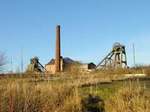
Section under re-construction
Water supply:
In the first instance, a good supply of water would be required for the production of lime mortar used for the construction of the twin engine-house complex and the essential surface buildings such as boiler-houses, workshops and offices etc. The lime itself was produced by burning the local magnesian limestone in a number of kilns located along the northern edge of the colliery site, the stone being quarried a short walk away.
Map showing old lime kilns & quarry here
Once the colliery was operational, substantial quantities of good water would be required for the boilers supplying the winding engines and the those driving the screens etc. Copious quantities of water were encountered during the sinking and this would normally have been tapped in order to provide a supply for the pit. Unfortunately it was found to have a very adverse effect on the boilers and an alternative supply had to be found. In 1892 the water supply for the pit was being provided by a steam driven pump located in an engine-house near the Horse-Fair spring although it’s not clear whether the water was extracted from the nearby spring itself or from the river about 150 yd (138 m) away.
Map showing old pump here
By 1900, the engine-house had been demolished and replaced by a building situated near to the banks of the river. A small weir was erected across the river to create a reservoir with a channel running towards the pump-house protected from larger debris by a perforated steel plate.
A large stilling tank was constructed next to the pump-house to remove suspended sediment. It is believed that the pump was electrically powered with a steam pump available as standby. By the 1960s only the electrically driven pumps were in use.
Map showing new pump house here
Photo of pump house weir here
Copyright © 2005 - 2020 J S. Thatcher
Page updated on:
07 Aug, 2023
at
07:44:10 PM
In case of problems contact: